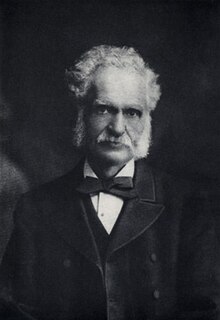Henry Walter Bates
Henry Walter Bates (born February 8, 1825 in Leicester , England , † February 16, 1892 in London ) was an English naturalist, evolutionary biologist and entomologist . He became famous for his expedition to the Amazon , which he began with Alfred Russel Wallace in 1848. By the time he returned from Brazil in 1859, Bates sent more than 14,000 species (mostly insects), 8,000 of which were new to science, to England. He was an early proponent of Charles Darwin's theory of evolution . The 'Bates'sche mimicry ' is named after him.
Life
Henry Walter Bates was born on February 8, 1825 in Leicester, the eldest of four sons of a knitwear manufacturer (Henry Bates). At the age of 13 he began an apprenticeship at a knitwear dealer. In his spare time he collected insects. In 1843 he published a short work on beetles in the magazine "Zoologist". He made friends with Alfred Russel Wallace, who was also a passionate entomologist. After reading William Henry Edwards' book about his Amazon expedition, they decided to travel the tropical rainforest themselves and to finance their trip by selling the collected specimens of insects. Bates left his job as an office worker and they set off on their expedition together.

In 1848 they landed in Pará (now Belém ), where they stayed for a year and a half and from where they undertook their excursions in the mouth of the Amazon. In 1850 they parted ways and everyone researched and collected for themselves.
For three years, Santarém (Pará) was the main base for Bates. From here he explored the area and the Rio Tapajós , one of the largest tributaries of the Amazon. Again and again he sent collected specimens (mammals, birds, reptiles, fish, insects, molluscs, zoophytes (fixed marine animals)) to museums and collectors in Europe. He moved further upstream and researched flora and fauna in the area of Ega (now Tefé ), Fonte Boa and finally São Paulo de Olivenca near the Peruvian border. After eleven years in Brazil, he returned to England in 1859.
Through his journey he made essential contributions to the understanding of evolution. He discovered the 'Bates' mimicry, which was later named after him: Harmless animals take on the appearance ( warning costume ) of defensive or inedible animals and thereby deceive their enemies.
In 1863 he married Sara Ann Mason.
After an unsuccessful application for a position at the zoological department of the British Museum , he worked from 1864 as an employee of the Royal Geographical Society . In 1881 he became a member of the Royal Society in London. Henry Walter Bates died of bronchitis on February 16, 1892.
Works
- Contributions to an Insect Fauna of the Amazons Valley. Lepidoptera: Heliconiidae (1862). Darwin praised this essay as one of the most remarkable and admirable papers I ever read in my life. ("as one of the most remarkable and admirable essays I have ever read in my life").
- The Naturalist on the River Amazons (1863). The book describes the voyage of discovery from 1848 to 1859 in the Amazon region.
- Editor of Transactions of the Royal Geographical Society
- Contributions to Zoologist , Entomological Society's Journal , Annals and Magazine of Natural History, and Entomologist
- On the Amazon: life of the animals, customs and habits of the inhabitants, description of nature under the equator and adventure during an eleven-year stay . Greno, Nördlingen 1989, ISBN 978-3-89190-355-1 , series Die Other Bibliothek .
Honors
- Knight of the Order of the Rose , Brazil
- Member of the Royal Society
See also
literature
- Bates, Henry Walter . In: Encyclopædia Britannica . 11th edition. tape 3 : Austria - Bisectrix . London 1910, p. 509 (English, full text [ Wikisource ]).
Web links
- Literature by and about Henry Walter Bates in the catalog of the German National Library
- Bates: The Naturalist on the River Amazons . Project Gutenberg (English)
- Entry to Bates; Henry Walter (1825–1892) in the Archives of the Royal Society , London
- Article about Bates on welt.de
Individual evidence
- ↑ The Little Encyclopedia . Encyclios-Verlag, Zurich 1950, volume 1, page 137
- ^ HW Bates: Contributions to an insect fauna of the Amazon Valley. Lepidoptera: Heliconidae . In: Transactions of the Linnean Society (London) , Volume 23, No. 3, 1862, pp. 495 ff.
- ^ First edition: The naturalist on the River Amazons, a record of adventures, habits of animals, sketches of Brazilian and Indian life and aspects of nature under the Equator during eleven years of travel. John Murray, London 1863, 2 volumes. ( Digitized version ), Library of Congress, Rare Book Selections.
| personal data | |
|---|---|
| SURNAME | Bates, Henry Walter |
| BRIEF DESCRIPTION | English naturalist, evolutionary biologist and entomologist |
| DATE OF BIRTH | February 8, 1825 |
| PLACE OF BIRTH | Leicester |
| DATE OF DEATH | February 16, 1892 |
| Place of death | London |
